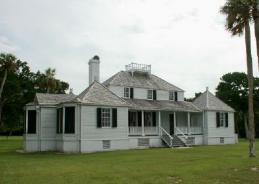


Marshes of the Preserve
The Timucuan Preserve
protects both historic sites
and a vital ecological area.
The Timucuan Preserve
protects both historic sites
and a vital ecological area.
Fort Caroline
The national memorial
explores the history of the
French settlement on the St.
Johns River.
The national memorial
explores the history of the
French settlement on the St.
Johns River.
Timucuan Ecological and Historic Preserve - Jacksonville, Florida
ExploreSouthernHistory.com - Timucuan Ecological & Historic Preserve, Florida
ExploreSouthernHistory.com - Timucuan Ecological & Historic Preserve, Florida

| Kingsley Plantation House The oldest plantation house in Florida is preserved and interpreted by the National Park Service as part of the Timucuan Ecological and Historic Preserve. |
Preserving History and Nature
One of the most beautiful national park areas
in the South is also among its most historic
and ecologically significant.
Encompassing thousands of acres of
coastal land in the Jacksonville area, the
Timucuan Ecological and Historic Preserve
protects environmentally sensitive wetlands
surrounding the mouth of the St. Johns River
as well as some of Florida's most significant
historic sites.
Established in 1988, the Timucuan Preserve
includes 46,000 acres and is named for the
Timucua, a native people who lived in the
region when Spanish and French explorers
arrived during the 1500s. The Timucua lived
in and around the St. Johns estuary where
they could hunt, fish and collect shellfish. The
large shell mounds formed as they ate
oysters and other shellfish dot the preserve.
Although the Spanish claimed all of North
America, the French made the first serious
effort to plant a European colony on the St.
Johns. Explorer Jean Ribault arrived in 1562
and erected a monument at the mouth of the
river. He was followed by French soldiers
and settlers, who journeyed from France in
1564 to establish Fort Caroline on the south
bank of the St. Johns.
Angry that the French had established a fort
on what he regarded as Spanish land, King
Phillip II sent Admiral Pedro Menendez de
Aviles to dislodge the French. He did so in
bloody fashion, attacking Fort Caroline in
1565 and slaughtering its soldiers. The
Spanish then reoccupied the fort, naming it
San Mateo.
Farms and mission settlements were
established in the Preserve by the Spanish,
as the Timucua slowly faded away. By the
time of the American Revolution, Florida had
passed into the hands of the British and a
large English settlement stood at St. Johns
Bluff. Several skirmishes and battles were
fought in Northeast Florida between the
British and American troops from Georgia.
The second Spanish era (1873-1821) saw a
rapid expansion of farming in the Timucuan
Preserve. Plantations were established to
take advantage of the rich soil of the coastal
islands and the easy transportation routes
provided by the rivers and creeks of the area.
The best known of these was the farm on
Fort George Island later to be purchased by
Zephaniah Kingsley. The plantation house
there, now preserved and interpreted by the
National Park Service, was built by slaves in
1798 and is the oldest in Florida. Kingsley
bought the plantation in 1814, seven years
in the South is also among its most historic
and ecologically significant.
Encompassing thousands of acres of
coastal land in the Jacksonville area, the
Timucuan Ecological and Historic Preserve
protects environmentally sensitive wetlands
surrounding the mouth of the St. Johns River
as well as some of Florida's most significant
historic sites.
Established in 1988, the Timucuan Preserve
includes 46,000 acres and is named for the
Timucua, a native people who lived in the
region when Spanish and French explorers
arrived during the 1500s. The Timucua lived
in and around the St. Johns estuary where
they could hunt, fish and collect shellfish. The
large shell mounds formed as they ate
oysters and other shellfish dot the preserve.
Although the Spanish claimed all of North
America, the French made the first serious
effort to plant a European colony on the St.
Johns. Explorer Jean Ribault arrived in 1562
and erected a monument at the mouth of the
river. He was followed by French soldiers
and settlers, who journeyed from France in
1564 to establish Fort Caroline on the south
bank of the St. Johns.
Angry that the French had established a fort
on what he regarded as Spanish land, King
Phillip II sent Admiral Pedro Menendez de
Aviles to dislodge the French. He did so in
bloody fashion, attacking Fort Caroline in
1565 and slaughtering its soldiers. The
Spanish then reoccupied the fort, naming it
San Mateo.
Farms and mission settlements were
established in the Preserve by the Spanish,
as the Timucua slowly faded away. By the
time of the American Revolution, Florida had
passed into the hands of the British and a
large English settlement stood at St. Johns
Bluff. Several skirmishes and battles were
fought in Northeast Florida between the
British and American troops from Georgia.
The second Spanish era (1873-1821) saw a
rapid expansion of farming in the Timucuan
Preserve. Plantations were established to
take advantage of the rich soil of the coastal
islands and the easy transportation routes
provided by the rivers and creeks of the area.
The best known of these was the farm on
Fort George Island later to be purchased by
Zephaniah Kingsley. The plantation house
there, now preserved and interpreted by the
National Park Service, was built by slaves in
1798 and is the oldest in Florida. Kingsley
bought the plantation in 1814, seven years
before Florida became a U.S. Territory. In a
unique twist of fate, the slave-holding
Kingsley became a noted crusader for the
rights of free blacks. He ultimately left the
country for Haiti in disgust over the treatment
of free blacks in America.
In addition, the Timucuan Ecological and
Historic Preserve includes the historic
Ribault Club and other points of interest.
Located along the Atlanta Coast both north
and south of the St. Johns River, the Timucan
Preserve can be accessed via numerous
points in Jacksonville. Key access roads
leading into the park are Mount Pleasant and
Fort Caroline Roads south of the river and
Heckscher Drive, Highway A1A and Cedar
Point Road north of the river.
Please click here to visit the Preserve's
website for more information and follow the
links below for closer looks at some key
points of interest.
unique twist of fate, the slave-holding
Kingsley became a noted crusader for the
rights of free blacks. He ultimately left the
country for Haiti in disgust over the treatment
of free blacks in America.
In addition, the Timucuan Ecological and
Historic Preserve includes the historic
Ribault Club and other points of interest.
Located along the Atlanta Coast both north
and south of the St. Johns River, the Timucan
Preserve can be accessed via numerous
points in Jacksonville. Key access roads
leading into the park are Mount Pleasant and
Fort Caroline Roads south of the river and
Heckscher Drive, Highway A1A and Cedar
Point Road north of the river.
Please click here to visit the Preserve's
website for more information and follow the
links below for closer looks at some key
points of interest.

St. Johns River
The monument overlook
offers a spectacular view of
the mouth of the St. Johns.
The monument overlook
offers a spectacular view of
the mouth of the St. Johns.

The Ribault Monument
French explorer Jean Ribault
erected a column at the
mouth of the St. Johns River
in 1562 to mark France's
claim to the region.
French explorer Jean Ribault
erected a column at the
mouth of the St. Johns River
in 1562 to mark France's
claim to the region.

Kingsley Plantation
Fort George Island
Ribault Club and Mission Site
Fort Caroline National Memorial
Ribault Monument
Battle of St. Johns Bluff
Yellow Bluff Fort State Park
Jacksonville Area Historic Sites
Historic Sites of Florida
Historic Sites of the South
Fort George Island
Ribault Club and Mission Site
Fort Caroline National Memorial
Ribault Monument
Battle of St. Johns Bluff
Yellow Bluff Fort State Park
Jacksonville Area Historic Sites
Historic Sites of Florida
Historic Sites of the South




Custom Search
| Copyright 2011 by Dale Cox All rights reserved. |

